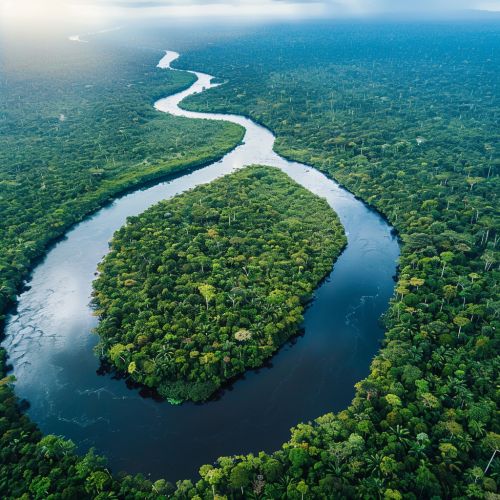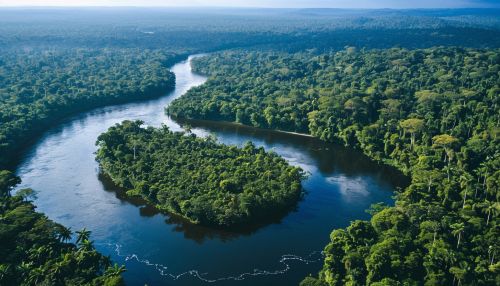Xingu River
Introduction
The Xingu River is a significant watercourse in northern Brazil, flowing through the states of Mato Grosso and Pará. It is a major tributary of the Amazon River and is renowned for its ecological diversity and cultural significance. The Xingu River basin encompasses a vast area of tropical rainforest, home to numerous indigenous communities and a rich array of flora and fauna. This article delves into the geographical, ecological, cultural, and economic aspects of the Xingu River, providing an in-depth exploration of its importance and challenges.
Geography
The Xingu River originates in the Brazilian Highlands, specifically in the state of Mato Grosso. It flows northward for approximately 1,640 kilometers before joining the Amazon River near the city of Altamira in Pará. The river's basin covers an area of about 531,250 square kilometers, making it one of the largest river basins in Brazil.
Tributaries
The Xingu River has several significant tributaries, including the Iriri, Bacajá, and Fresco rivers. These tributaries contribute to the river's substantial flow and play a crucial role in the hydrological dynamics of the region. The Iriri River, in particular, is one of the longest tributaries, extending over 1,300 kilometers.
Hydrology
The hydrology of the Xingu River is characterized by a tropical monsoon climate, with distinct wet and dry seasons. The river experiences its highest flow during the rainy season, which typically occurs from December to May. During this period, the river's discharge can increase dramatically, leading to extensive flooding in the surrounding areas. Conversely, the dry season, from June to November, sees a significant reduction in water levels.


Ecology
The Xingu River basin is a biodiversity hotspot, hosting a wide variety of plant and animal species. The river and its surrounding forests provide critical habitats for numerous endemic and endangered species.
Flora
The vegetation in the Xingu River basin is predominantly tropical rainforest, characterized by high species diversity and complex ecological interactions. Key plant species include various types of hardwood trees, palms, and epiphytes. The region is also home to several economically important species, such as rubber trees and Brazil nuts.
Fauna
The fauna of the Xingu River basin is equally diverse, with numerous species of mammals, birds, reptiles, and fish. Notable mammalian species include jaguars, tapirs, and several species of monkeys. The river itself is home to a rich array of fish species, many of which are endemic to the region. The Xingu River is particularly famous for its unique fish fauna, including species such as the zebra pleco (Hypancistrus zebra) and the Xingu River ray (Potamotrygon leopoldi).
Indigenous Communities
The Xingu River basin is home to several indigenous communities, each with its own distinct culture and traditions. These communities have lived in harmony with the river and its ecosystems for centuries, relying on its resources for their livelihoods.
Cultural Significance
For the indigenous peoples of the Xingu, the river is not just a source of water but a vital part of their cultural and spiritual identity. The river features prominently in their myths, rituals, and daily practices. Traditional fishing, agriculture, and hunting are integral to their way of life, and the river's health is closely tied to their well-being.
Challenges and Threats
Despite their deep connection to the land, indigenous communities in the Xingu River basin face numerous challenges. Deforestation, mining, and large-scale agricultural projects pose significant threats to their traditional territories. Additionally, the construction of hydroelectric dams, such as the Belo Monte Dam, has led to displacement and environmental degradation, further impacting their way of life.
Economic Importance
The Xingu River plays a crucial role in the regional economy, supporting various economic activities such as agriculture, fishing, and hydroelectric power generation.
Agriculture
The fertile floodplains of the Xingu River are ideal for agriculture, supporting the cultivation of crops such as cassava, maize, and rice. Additionally, the region is known for its production of tropical fruits, including mangoes, bananas, and papayas. However, large-scale agricultural expansion has led to deforestation and habitat loss, raising concerns about the long-term sustainability of these practices.
Fishing
Fishing is a vital economic activity for both indigenous and non-indigenous communities along the Xingu River. The river's rich fish fauna provides a crucial source of protein and income. Traditional fishing methods, such as the use of nets and traps, coexist with more modern techniques. However, overfishing and habitat destruction pose significant threats to fish populations and the livelihoods of local communities.
Hydroelectric Power
The Xingu River has significant potential for hydroelectric power generation, and several dams have been constructed along its course. The most notable of these is the Belo Monte Dam, one of the largest hydroelectric projects in the world. While these projects contribute to Brazil's energy needs, they have also sparked controversy due to their environmental and social impacts.
Conservation Efforts
Given the ecological and cultural significance of the Xingu River, various conservation efforts have been undertaken to protect its ecosystems and indigenous communities.
Protected Areas
Several protected areas have been established within the Xingu River basin to safeguard its biodiversity. These include national parks, indigenous reserves, and sustainable use reserves. Notable examples include the Xingu Indigenous Park and the Terra do Meio Ecological Station. These protected areas play a crucial role in preserving the region's unique flora and fauna.
Environmental Organizations
Numerous environmental organizations are active in the Xingu River basin, working to promote sustainable development and conservation. These organizations collaborate with local communities, government agencies, and international partners to address environmental challenges and advocate for the rights of indigenous peoples.
Future Prospects
The future of the Xingu River and its surrounding ecosystems is uncertain, given the numerous challenges it faces. Climate change, deforestation, and infrastructure development continue to pose significant threats. However, ongoing conservation efforts and increased awareness of the river's importance offer hope for its preservation.
Sustainable Development
Promoting sustainable development practices is essential for the long-term health of the Xingu River basin. This includes implementing sustainable agricultural practices, protecting critical habitats, and ensuring that infrastructure projects are designed with minimal environmental impact. Additionally, empowering indigenous communities and respecting their traditional knowledge is crucial for achieving sustainable outcomes.
Climate Change Mitigation
Addressing climate change is vital for the future of the Xingu River. Efforts to reduce greenhouse gas emissions, protect forests, and enhance the resilience of ecosystems are essential components of climate change mitigation. International cooperation and support are also critical in addressing the global nature of this challenge.
Conclusion
The Xingu River is a vital lifeline for the ecosystems and communities of northern Brazil. Its rich biodiversity, cultural significance, and economic importance underscore the need for comprehensive conservation and sustainable development efforts. By balancing the needs of nature and human society, it is possible to ensure the long-term health and vitality of the Xingu River and its basin.
